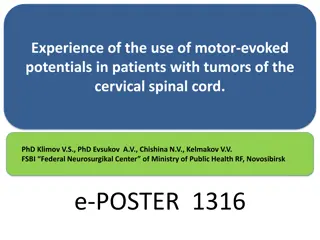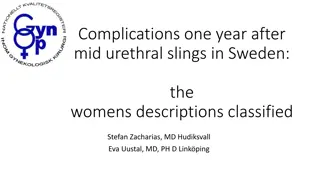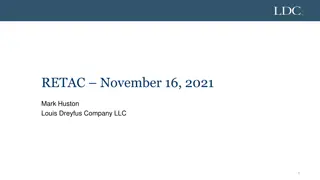
Impact of Omission of Intraoperative Frozen Section on Urethral Margins
Investigate the effects of omitting intraoperative frozen section prior to orthotopic neobladder reconstruction on urethral margins and recurrence rates. This retrospective study analyses data from 390 patients who underwent radical cystectomy between 2007 and 2017 at a university urology department.
Download Presentation

Please find below an Image/Link to download the presentation.
The content on the website is provided AS IS for your information and personal use only. It may not be sold, licensed, or shared on other websites without obtaining consent from the author. If you encounter any issues during the download, it is possible that the publisher has removed the file from their server.
You are allowed to download the files provided on this website for personal or commercial use, subject to the condition that they are used lawfully. All files are the property of their respective owners.
The content on the website is provided AS IS for your information and personal use only. It may not be sold, licensed, or shared on other websites without obtaining consent from the author.
E N D
Presentation Transcript
Journal Club urology department benha university 2019
The Impact of Omission of Intraoperative Frozen Section Prior to Orthotopic Neobladder Reconstruction
ARTICLE CITATION THE JOURNAL OF UROLOGY , Vol. 202, 763-769, October 2019
Study objective Current guidelines recommend confirming a negative urethral margin prior to orthotopic neobladder reconstruction. We investigated our rate of urethral positive margins and recurrence in the absence of intraoperative frozen section.
Study design a retrospective study
Target population (Inclusion and exclusion critieria) We used our institutional, retrospective, Institutional Review Board approved database of patients who underwent radical cystectomy at our institution between 2007 and 2017 Patients who underwent cystectomy for benign etiologies or nonurothelial bladder cancer were excluded from analysis. preoperative imaging concerning for T4 disease was a relative contraindication to orthotopic diversion.
Patients and methods Demographic and clinical data were available on 390 patients with orthotopic urinary diversion. All patients were confirmed not to have undergone intraoperative frozen section of the urethra
Follow up Patients were followed postoperatively with physical examination, cross-sectional imaging of the abdominal pelvis and chest x-ray every 6 months for 2 years, annually until year 5 and then biannually until progression or loss to followup. Investigations into urethral recurrence, including cystoscopy and voided cytology, were performed if symptoms (hematuria, irritative voiding and urinary retention) were present. Routine cystoscopic or cytological surveillance without symptoms was not standard practice. Recurrence-free survival data were collected during followup at our institution.
Statistical analysis (statistics used , ) Patient cohorts were compared using the Fisher exact test and the Mann- Whitney U test based on final urethral margin status. Kaplan-Meier survival analysis using the log rank test was performed to compare recurrence-free and overall survival between cohorts. Cox proportional hazards regression was used for multivariate survival analysis.
A total of 357 patients underwent radical cystectomy and orthotopic neobladder creation without intraoperative frozen section between 2007 and 2017. Of the patients 330 (92.4%) were male and 27 (7.6%) were female. Median age at surgery was 61 years . Definitive preoperative clinical staging was available in 343 patients, of whom 173 (50.6%) had nonMIBC and 170 had MIBC.
At the last followup 33 patients (9.2%) had died with bladder cancer, 32 (8.9%) had died without disease recurrence, 8 (7.0%) were alive with disease recurrence and 277 (74.9%) were alive without recurrence.
Six patients (1.68%) in the entire cohort were found to have urethral recurrence. Only 1 of these patients had a positive urethral margin on final pathology results. In 1 patient urethral recurrence was found to be synchronous with significant distant progression and local treatment of the urethra was not done. The remaining 5 patients underwent urethrectomy with ONB converted to an ileal conduit in 2 and to continent cutaneous diversion in 3 .
Discussion The general consensus in the major urological organizations (the AUA and the EAU) is to ensure negative frozen section or negative urethral sampling prior to performing ONB surgery
In our series we found a 1.6% urethral recurrence rate, comparable to that in prior institutional retrospective series of orthotopic neobladder diversion, which range from 1.4% to 5%. All prior series have required negative intraoperative frozen section or negative preoperative prostatic urethral biopsy to be eligible for ONB
Our 4.2% final positive urethral margin rate is elevated compared to that in other series, in which the incidence ranges from 1.1% to 2.4%. This may be attributable to selection bias in other series which excluded patients with positive intraoperative frozen section, or preoperative prostatic or bladder neck involvement.
The rate of urethral recurrence with a positive margin was 5.6% compared to 1.6% in the negative margin group. This was not statistically significant, although to our knowledge we report the largest published series of positive urethral margins in ONBs.
In our series overall survival in patients with a positive urethral margin did not differ compared to that in patients with a negative final urethral margin. Although the recurrence risk was elevated in patients with positive margins, this effect was not significant when accounting for known survival risk factors
Intraoperative frozen section attempts to ensure complete excision of local disease to prevent local recurrence. In our series there was no difference in the urethral recurrence rate based on urethral margin status. Likewise, previous dogmatic markers of disease proximity to the urethra such as prostatic CIS or prostatic stromal invasion were recently not shown to be associated with urethral recurrence after ONB reconstruction in a large meta-analysis.
In this study we attempted to address the question of whether intraoperative frozen section is necessary in patients who elected ONB. There remains an element of uncertainty in interpreting frozen section.
While intraoperative frozen section has greater than 99% negative predictive patients with a positive intraoperative urethral frozen value, only 46% of section ultimately have a positive surgical margin. This creates a clinical dilemma as there is potentially a nearly 50% risk of a negative margin after intraoperatively changing to incontinent urinary diversion due to frozen section.
We believe that in the absence of obvious T4 prostatic invasion clinically in the operating room or on preoperative imaging obtaining an intraoperative frozen urethral margin prior to ONB creation is unnecessary, does not impact cancer specific outcomes and may lead to worse continence and increased costs.
Omitting intraoperative frozen section of the urethra prior to orthotopic neobladder construction did not result in a higher rate of urethral recurrence than that in contemporary series despite an increased positive urethral margin rate on final pathology findings. We report that only 1 of 15 patients with a positive urethral margin ultimately required urethrectomy and urinary repeat diversion for urethral recurrence. In patients without gross tumor at the distal urethral margin it is safe to proceed with orthotopic urinary diversion without routine intraoperative frozen section.





















